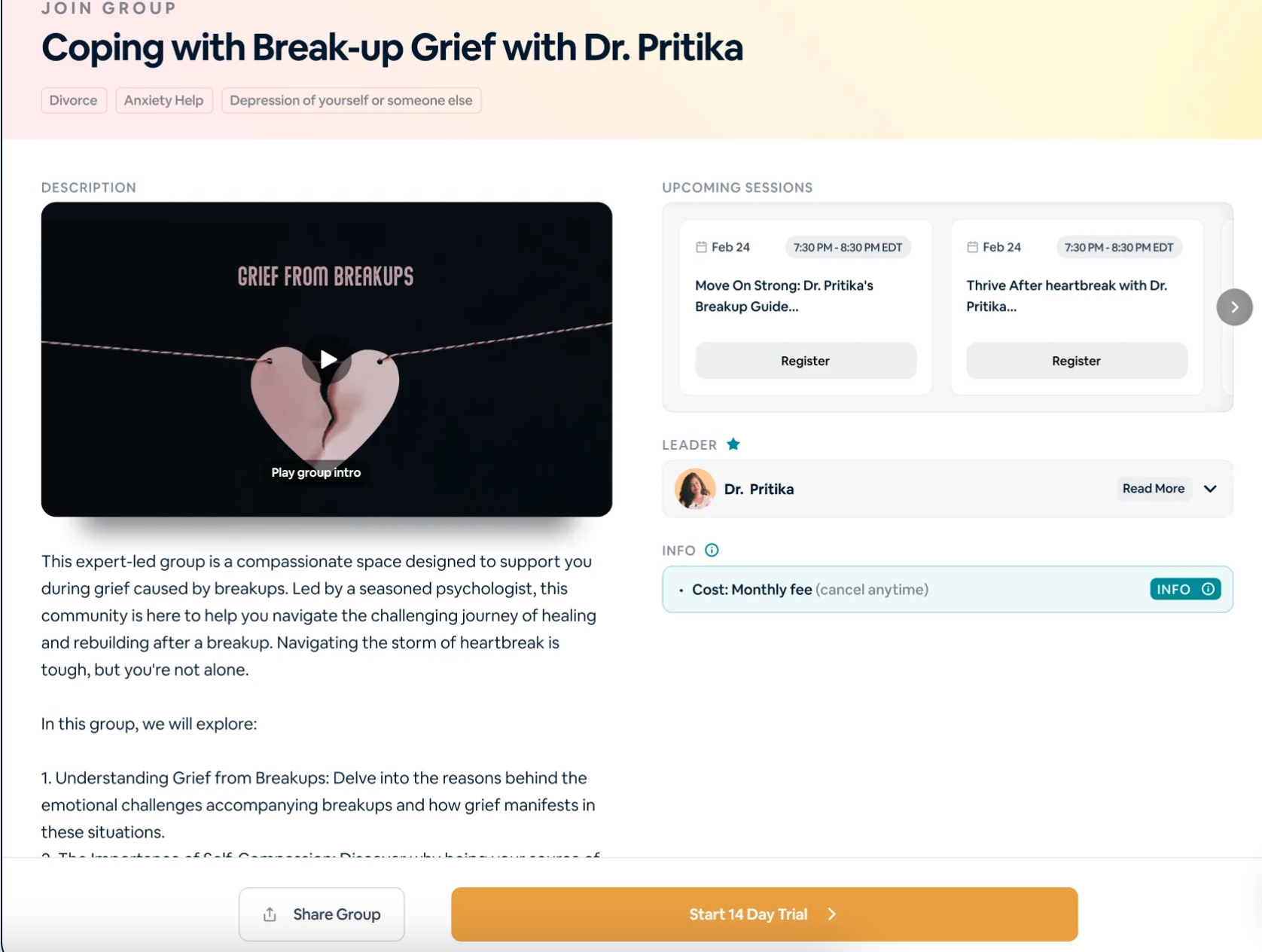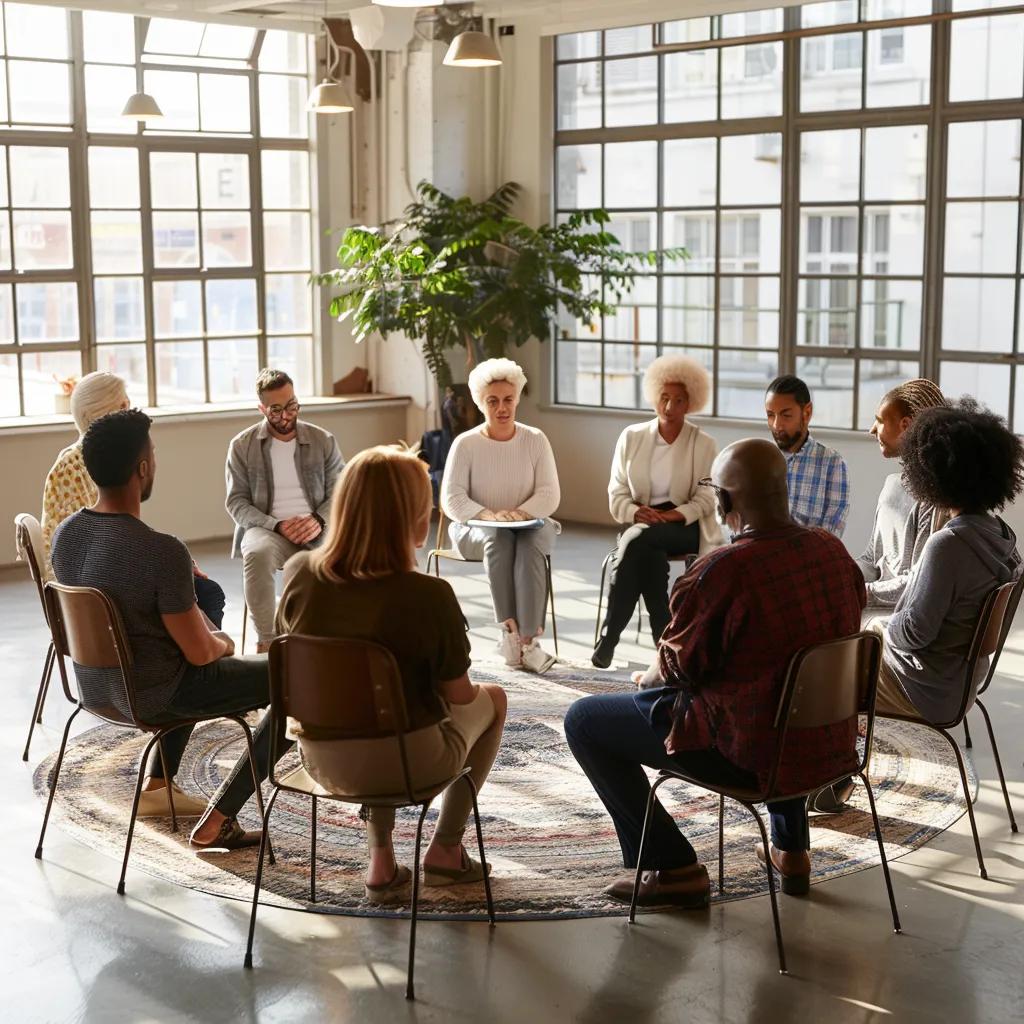





What if one safe space could change someone’s entire healing journey?
Imagine a place where quiet self-doubt turns into bold confidence. Where grief softens through shared stories. And where loneliness fades into real connection.
I’ve seen it happen—again and again.
As a health professional and mental health advocate, I’ve witnessed the powerful transformation that peer support groups can spark. It all started with Confidence Crew—a virtual circle on MentalHappy for people battling inner doubt.
What began as a simple idea became a lifeline. Now, I’m here to help you build your own. Whether you’re a facilitator, peer supporter, or just someone who cares deeply about mental wellness, this guide is for you. Step by step, I’ll show you how to host your first virtual support group session—with empathy, intention, and MentalHappy’s powerful tools.
Let’s create a space where healing isn’t just possible—it’s shared.
The first step in hosting a successful peer support group session is defining your group’s purpose and audience. Identify the core challenge your group will address—whether it’s anxiety, grief, self-confidence, or another mental health concern. Understanding your target demographic, such as teens, working professionals, or new parents, will help tailor your discussions to meet their unique needs. For example, Confidence Crew focuses on adults facing self-doubt in their careers and personal lives, ensuring that topics and strategies are relevant to their experiences.
Once your purpose is clear, structuring your sessions effectively is key. Decide on a frequency that balances engagement and reflection—weekly, biweekly, or monthly. Mental Happy’s Schedule Session feature allows you to automate reminders, ensuring consistency and reducing drop-off rates. A well-structured session typically includes a warm-up (such as journaling, check-ins, or guided breathing exercises), a core discussion segment (themed topics, Q&A, or skill-building exercises), and a closing reflection (affirmations, gratitude sharing, or next steps for members to implement in their daily lives). This format supports stress management and emotional coping.
To build momentum before each session, engage your group members with pre-session activities. Upload resources such as journal prompts, affirmations, and situational questions directly to the group feed. For instance, you can post a prompt like, “What’s a small win you had this week?” or an affirmation such as, “I am worthy of success.” Creating visually appealing posts using Canva or Adobe Express can significantly boost engagement. Encouraging members to interact with these materials ahead of time helps them feel more prepared and invested in the discussion.
A welcoming environment is essential for meaningful participation. Posting an introductory message with a calming image or video can set a positive tone. Icebreakers, such as interactive quizzes (Google Forms or Quizizz), can ease initial hesitations. Clearly outlining group guidelines ensures that all members feel like they’re in a safe space, supported with confidentiality, information, and mutual attention.
To attract members to your support group, leverage internet and social media to spread awareness. Promote your group on Instagram, Facebook, LinkedIn, and Twitter using relevant hashtags like #MentalHealthSupport, #SelfCareCommunity, and #MentalHappy. Highlight key platform benefits such as anonymous chat and HIPAA-compliant video sessions to showcase what makes Mental Happy a unique and secure space for open discussions that support mental health awareness.
Collaborating with therapists, life coaches, or mental health influencers can help extend your reach. Cross-promoting your group with health professionals who share a similar audience ensures a steady influx of interested participants. Additionally, linking your Mental Happy group in social media bios and posts can make it easier for community members to find and join your organization.
Email and newsletter promotion can also be highly effective. Reach out to your existing audience through email campaigns with compelling calls-to-action, such as “Join a Safe Space to Rebuild Confidence.” Providing a direct link to your group encourages sign-ups and fosters a sense of exclusivity.
Starting your session with interactive conversations can set the stage for open and honest dialogue. Mental Happy’s Start Conversation tool is an excellent way to initiate discussion. Pose engaging questions like, “What’s one positive affirmation you tell yourself?” or “Describe a time when you overcame self-doubt.” This feature allows members to respond anonymously, reducing fear of judgment and promoting vulnerability, especially in peer support settings or therapy groups.
Video sessions add a personal touch to virtual support groups. Mental Happy’s HIPAA-compliant video integration ensures that all interactions remain private and secure. Providing members with a pre-session tech guide can help mitigate technical difficulties and ensure a smooth experience, particularly important for patients dealing with stress or coping with emotional challenges.
Encouraging anonymity can also be a game-changer for participation. Mental Happy allows members to interact being anonymous, creating a safe environment where they feel comfortable sharing. As a group facilitator, you have access to real names for accountability, but members only see it as anonymous, which helps maintain confidentiality while fostering trust.

To keep the momentum going, share key takeaways from each session. Posting a recap in bullet points or as an infographic ensures that all members, including those who couldn’t attend, stay informed and engaged. Tagging absent members in follow-up posts fosters inclusivity and reminds them of upcoming discussions. This is especially effective in peer support settings and helps support ongoing mental health awareness.
Providing continued resources is another way to keep members engaged. Upload relevant materials such as CBT worksheets, mindfulness exercises, or podcast recommendations to the group’s resource library. Having all materials in one easily accessible, secure location makes it convenient for members to revisit discussions and apply learnings at their own pace. These resources are commonly used by facilitators, health professionals, and caregivers as tools for emotional coping and stress management.
Encouraging peer interaction between sessions can strengthen the sense of community. Creating dedicated threads such as “Weekly Wins” (where members share small victories), “Reflection Friday” (for journaling thoughts on the week), or “Ask & Share” (a space for Q&A and peer insights) fosters ongoing engagement and deeper connections among members. These formats align with mental health first aid practices and build long-term resilience in patients and employees navigating healthcare challenges.
Mental Happy provides a secure, HIPAA-compliant platform that prioritizes privacy and data security in health care. The platform employs end-to-end encryption to protect all messages and video calls. Role-based access controls ensure that only authorized users can view sensitive Patient information, while audit trails allow group leaders to track engagement metrics without compromising confidentiality.
Engagement tools on the platform make it easy to enhance participation. Anonymous interactions encourage members to share openly without fear of stigma—a helpful feature in groups addressing substance abuse, addiction, domestic violence, or emotional therapy. The scheduled session feature automates reminders, reducing no-shows and keeping the group active. The resource library centralizes worksheets, exercises, and affirmations, providing 24/7 access to valuable mental health tools used by facilitators and caregivers alike.
MentalHappy also offers data-driven insights to help support group leaders refine their approach. Engagement analytics track participation trends, allowing leaders to adjust their strategies based on member behavior. Feedback tools enable group leaders to collect anonymous insights, ensuring that sessions continue to meet members' needs effectively.
Hosting a support group on Mental Happy is more than just leading discussions—it’s about fostering a space where individuals feel supported, understood, and empowered. With HIPAA-compliant video, anonymous interaction, and powerful engagement tools, you can build a thriving peer support community that makes a lasting impact for those navigating addiction, stress management, or emotional therapy.
Every support group is a lighthouse for someone lost in the storm. By hosting on MentalHappy, you’re not just leading discussions—you’re igniting hope, one shared story at a time. Whether you're a facilitator, health professional, or someone supporting Mental Health Awareness Month, you’re contributing to a culture of health, mental health, and care.
Remember the member who whispered, “This group taught me I’m worth defending”? That could be your legacy, especially in a world where healthcare access, insurance coverage, and emotional behavior support can shape someone’s path to healing.
If you’re ready to take the next step, visit MentalHappy to start your own support group. By providing a space for connection and healing, you can help individuals transform isolation into meaningful relationships and personal growth.

If you are in a life-threatening situation - DO NOT use this platform.
Use these resources to get immediate help.


